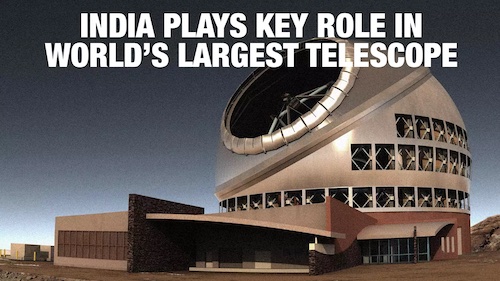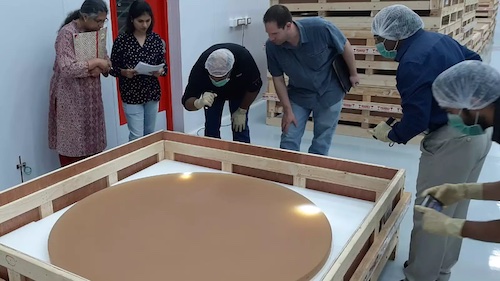Spectrometers and India
This is a collection of articles archived for the excellence of their content. |
High-resolution optical spectrometer
As in 2020 Jan
Rohan Dua, January 25, 2020: The Times of India

From: Rohan Dua, January 25, 2020: The Times of India
NEW DELHI: India’s contribution to the world’s largest telescope just got bigger. Apart from producing edge sensors, mirrors, actuators and electronics for the Thirty Metre Telescope (TMT) which is in development in Hawaii, India will also develop a high-resolution optical spectrometer (HROS) for it.
The spectrometer — a device that collects light waves and uses them to determine what material created the light — is expected to fast forward the telescope’s glimpse into formation of the first galaxies as well as Milky Way’s neighbour, Andromeda, while also mapping the elements formed during Big Bang such as hydrogen and helium. The HROS will cost Rs 435 crore and the money will come from the TMT fund which includes a pooled-in amount of $1.2 billion by US, India, Japan, Canada and China. It will be developed by the India TMT center set up in the campus of Indian Institute of Astrophysics (IIA) in Bengaluru.
Scientists from the US, Japan, Canada and China are also participating in the construction of TMT at Mount Mauna Kea. It will be the world’s most advanced and powerful ground-based telescope operating at optical and infrared telescope wavelengths and is expected to be operational by 2030. The telescope will study formation of first stars and galaxies, constitution of black holes, investigate dark matter and dark energy, and hunt for alien life. The design and build of various telescope systems has been distributed among the TMT partner institutes.
The HROS design proposed by the India TMT team was recently chosen by the Science Advisory Committee of TMT observatory ahead of those presented by other countries such as China. The optical spectrometer will gather light operating between 310 nanometers and 1100 nanometers, a much wider spectrum than any existing optical instrument. The HROS will have resolution capabilities of 25,000, 50,000 and 1,00,000 and will be placed along the aperture of the TMT telescope on a platform. The HROS will study cosmic chemical history, how the first elements — hydrogen, helium, lithium and deuterium — were produced during the Big Bang and enrichment of gases in galaxies by further generations of stars
Sivarani Thirupathi, professor, Indian Institute of Astrophysics
Professor Sivarani Thirupathi from IIA, who was involved in preparing the HROS design, told TOI that the spectrometer would have an improved signal-to-noise ratio. “For the first time, we will be able to obtain high-resolution spectroscopy of main sequence stars beyond the Milky Way and red giant branch (RGB) stars in Andromeda galaxy,” said Thirupathi. About 90% of the stars in the universe, including the sun, are main sequence stars — those undergoing fusion of hydrogen into helium within their cores. After main sequence, the stars move on to the RGB phase where their atmospheres expand.
The 3-D image rendition of TMT with its vents open in Hawaii The proposed HROS would also enable the TMT to study the sequence of dwarf stars beyond Milky Way as well as elements formed in the early universe, said Thirupathi. “The HROS will study cosmic chemical history, how the first elements — hydrogen, helium, lithium and deuterium — were produced during the Big Bang and enrichment of gases in galaxies by further generations of stars,” she said.
Eswar Reddy, project director at India-TMT, added that the HROS would give clues to the nature of first stars, primordial lithium abundances, pre-galactic magnetic fields and light-element production.
In addition to HROS, the TMT will have two other light gathering instruments, including IRIS (Infrared Red Imaging Spectrograph) being built by the University of California in Los Angeles and WFOS (Wide Field Optical Spectrometer) being built by the University of California in Santa Cruz.
Readying each mirror takes about three months and includes etching the surface to make it smoother to ensure zero scattering of light
Ramya Sethuram, project scientist, TMT
Meanwhile, work is on in full swing at India TMT Optics Fabrication Facility (ITOFF) set up in Bengaluru. Another TMT project scientist, Ramya Sethuram, told TOI that India is developing 86 mirrors for 493 mirror segments that will be used in the telescope. “Readying each mirror takes about three months and includes etching the surface to make it smoother to ensure zero scattering of light. Thereafter, it is kept in a stress-free support system. Together, the 86 pieces will take about 10 years to complete.”
Eye in the sky '
With HROS, TMT will be able to study elements like hydrogen, helium formed in the early universe
The TMT is the world's biggest optical telescope with 30-m mirror
Look deeper into our galactic neighbour, Andromeda
Glimpse at main sequence stars beyond Milky Way
